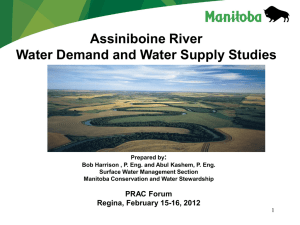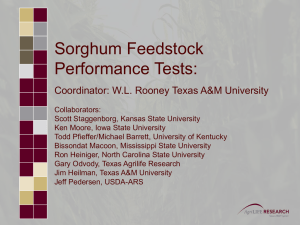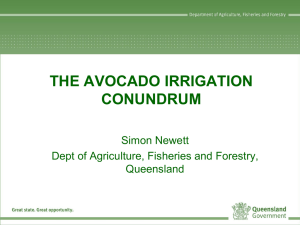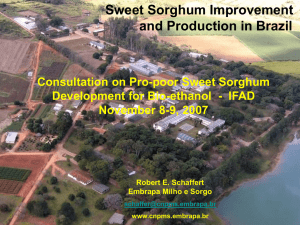5.4 Sorghum Ethiopia - Spate Irrigation Network
advertisement
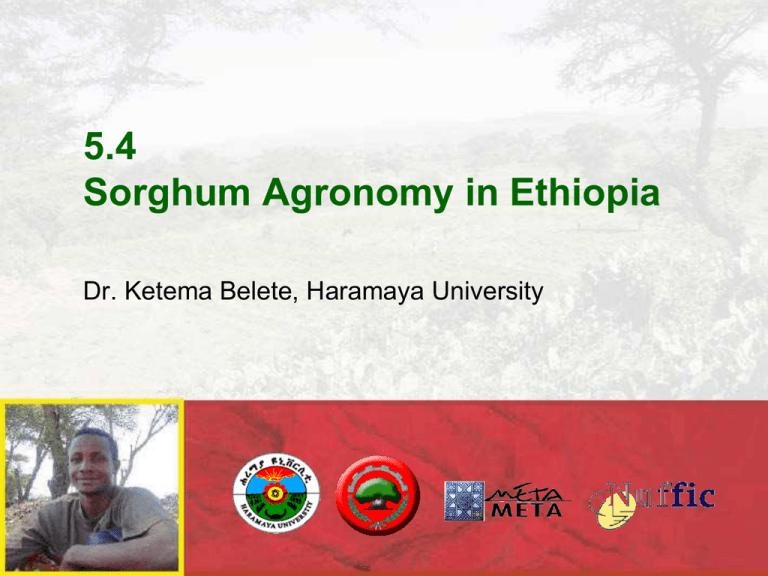
5.4 Sorghum Agronomy in Ethiopia Dr. Ketema Belete, Haramaya University Agronomic/cultural practices 1.Tillage 2. Seeding methods 3.Fertilizer application 4. Irrigation 5. Weed control 6. Plant protection Why sorghum? Major cereal in moisture limited areas One of the most drought resistant cereal ‘CROP CAMEL’ In Ethiopia – source of food, fodder, fuel and building material Crop Pearl millet Sorghum Maize Wheat Units of dry matter produced for every 1000 units water consumed 3.64 3.46 2.88 1.93 Agronomic/cultural practices 1. Tillage Purpose of tillage a. Improvement of soil structure b. Moisture conservation c. Soil aeration d. Root penetration e. Weed control F Seedbed preparation Agronomic/cultural practices … 2.. Seeding methods 2.1. Planting date - rule of thumb ‘availability of moisture at planting & during the vegetative/reproduction stage & its absence after maturity and at harvest’ 2.2. Planting depth Depends on seed size & soil type 2.5 to 5cm for sorghum vs 5 to 8cm for maize Agronomic/cultural practices ... 2.3. Seeding rate/ Row spacing/Planting density Depends on variety, fertility of soil & moisture in Ethiopia 5 to 8 kg/ha in US 7.5 to 12 kg/ha in Ethiopia 75 x 20cm, 75 x15cm in US 90 x15cm (rainfed), 75x15cm (spate irr.) in Ethiopia 67 000 to 90 000 plants/ha in US 75 000 to 125 000 plants/ha Plant density In Ethiopia since sorghum is used for fodder is constantly thinned – affecting the total yield This is due to a scarcity of other sources of fodder If intercropped with Labla this could be overcome Agronomic/cultural practices ... 3 Fertilizer application in Ethiopia N and P ( N kg/ha and P2O5kg/ha) DAP source of N and P at planting Urea source of N at knee height Important to have tailor-made applications Economical under dependable rainfall & irrigation In some spate soil natural fertility very high – would not need additional fertilizer – this would in fact even damage the crop Agronomic/cultural practices ... 4 Weeding/ control of Striga Microscopic seeds that can survive more than 20 yrs Seeds tap into rootstems of sorghum and ‘suck’ it If enough fertilizer/ moisture sorghum will be able to handle striga Approach: Use fertilizer/ moisture Use stryga resistant varieties Need to think of short duration varieties At the moment most sorghum varieties in Ethiopia are late-maturing This is in line with the practice of rain-fed farming and the year-round multipurpose functions of sorghum In spate irrigated areas – especially in the lowlands where there is no supplementary rainfall - short duration varieties are more useful Production Statistics of Sorghum Grain in 1998 (Source UN 1999) Country Egypt Eritrea Ethiopia Kenya Sudan India US Harvested area (103ha) 156 236 982 140 6405 10238 3125 Average yield (Kg/ha) 5769 1144 1103 929 671 833 4226 Agronomic/cultural practices ... 5. Irrigation - not widely used in Ethiopia for cereal production - stored soil moisture for maximum yield is 50 to 60 cm - preplant irrigation that wets the soil to field capacity to a depth of 2m is best – signifying the importance of adequate moisture conservation - maximum water usage occurs - at boot stage of the plant growth Amount of water extracted from various depths by a sorghum crop during a growing season (W.M.Ross& O.J.Webster. 1970. Culture and Use of Grain Sorghum) Soil Depth (m) Percent of Total 0.0-0.3 Water Absorbed (cm) 22.6 0.3 - 0.6 16.8 26 0.6 - 0.9 10.2 16 0.9 - 1.2 7.1 11 1.2 -1.8 3.3 5 35 Daily water use for grain sorghum This is when crops need most water – this can also be provided from conserved moisture and capillary rise (in colder season) In this season no irrigation or rainfall is required – it would only delay the drying of the seed and the harvest 10 8 6 4 2 0 0 7-leaf Rapid stage growth stage 20 40 Boot stage 60 Bloom stage 80 Grain filling stage Days After Planting 100 Harvest 120 140 Interaction of Irrigation and Fertilizer (E.F.Bennett., B.B. Tucker& A. B. Maunder. 1990. Modern Grain Sorghum Production) Some effect but not dramatic Time and number of irrigation Preplant and preboot, 2 Irr Preplant, preboot, and milk, 3 Irr. Preplant, preboot, flower, and milk, 4 Irr. Grain Yield (Kg/ha) No fertilizer With fertilizer 5645 5799 5964 6468 7039 8120 General points Average yield of irrigated sorghum have increased by 82% more than non-irrigated sorghum Moisture needed to produce acceptable yield is approximately 40 to 50 cm Maximum yield requires 50 to 65 cm moisture Roots of sorghum extract soil moisture from up to 2m of soil depth. Water use by the plant At planting it is needed for good seed to soil content adequate soil moisture proper germination temperature (min. 10oC) the above 3 ensure good stand establishment Water use by the plant (cont..) At Seedling stage amount of moisture taken up is low availability of sufficient moisture is critical root zone is less than 45 cm, thus deeper soil moisture is not needed soil moisture is not depleted rapidly more moisture is lost by evaporation from soil than transpiration through the crop canopy water conservation practices to minimize soil moisture losses • • • • residue management narrow row spacing proper planting date weed control Water use by the plant (cont..) At rapid growth stage and reproduction stage (Example based on early maturing variety 150 days) starts as of about 30 days after emergence (7 to 8 leaves stage) pick at boot stage and bloom stage (about from 50 to 80 DAE)

